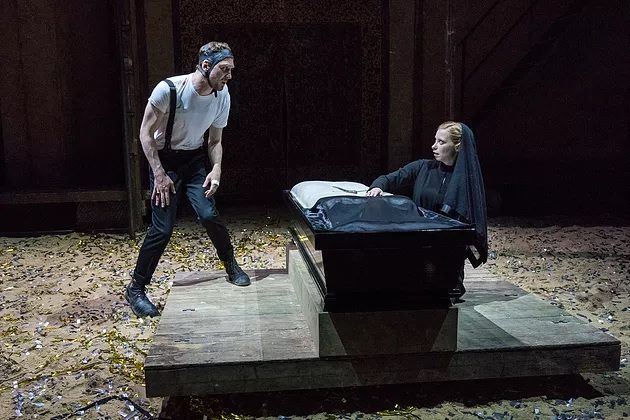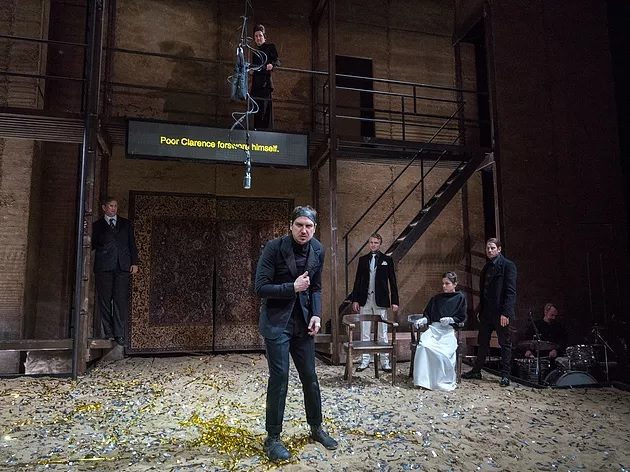Richard Crookback is Shakespeare’s dazzling carnival monster, a showoff criminal who charms us into reveling in his villainy. It’s a no-brainer to make him funny-scary in production. Or over-the-top disgusting, or intimidating, or lurid, or for that matter attractive. The sole requirement is a big, game ham.
What’s really difficult—close to impossible, actually, after 424 years of sensationalizing—is to make him genuinely disturbing, to portray this monster in a way that breaks through our psychic defenses and plants sticky misgivings about ourselves and our world in our minds. Thomas Ostermeier’s astonishing production of Richard III, visiting BAM from the Schaubühne in Berlin, got there with me about two thirds through, during what would otherwise have seemed a cheesy interlude of audience participation. More on that in a moment.
The show is an ordeal and is meant to be. For two and half intermissionless hours Lars Eidinger, who plays Richard, treats the stage as his personal terror-playground. The set is a semicircular sandbox backed by a two-tier metal gallery and steps, and he swans and struts about it, his head wrapped in what looks like a medical skull strap, implying that his character’s deformities are natural advantages. His hump and clubfoot are just appliances, casually removed or revealed as necessary as he coaxes, lies and bullies to get his way. The appliances aren’t restrictions but rather graphic reminders that he’s “marked” in obvious ways to others in his world—they know he’s questionable but don’t see how deep his malice goes.
In fact, Eidinger is physically freer as Richard than any other actor I’ve seen. He strips naked at one point to woo Lady Anne. His most vital accessory isn’t even on his body but rather on the stage. It’s a mic hanging from the flies that functions also as a spotlight, video camera and trapeze line (the rigging for this device must be a nightmare). Eidinger uses it in nearly every scene in marvelously different ways—confiding or cracking wise, swinging or whipping the wire, magnifying his face, or generally presiding like a demented emcee. You can’t wait to see what he does next with it.
Only once does he appear physically confined or inhibited by anything. Interestingly enough, that’s after he’s crowned king and dons a stiff corset and plastic neck brace. The irony is so glaring it’s moving. Power is the one true disability, as we’ve seen to our revulsion with Harvey Weinstein.
The production’s decisive moment comes in Act IV, after Buckingham, the character who helps Richard murder his way to the throne, is cheeky enough to ask for his promised earldom. Eidinger’s response is to smear a plate of oleaginous brown food across the Buckingham actor Moritz Gottwald’s face and torso. He then piles it on with an obscene, juvenile taunt: “Hey, you look like shit! Have you eaten pussy yet today?” Frankly, I yawned at that. At first.
But Eidinger pushed it further. He dashed into the audience repeating the lines in German, then switched to English, pumping the crowd to get them to shout the lines along with him as a jeering cheer. That’s when I gulped. A hundred or more presumably liberal, sophisticated, evolved and enlightened BAM-goers gleefully took up the prompt, shouting those foul words aloud again and again like 12-year-olds on a dare. Who the fuck were these people? I thought I knew. And what else might they do in the anonymity of a crowd? The Harvey Theater suddenly felt like an unsafe space.
“Murderers are not monsters, they’re men. And that’s the most frightening thing about them,” wrote Alice Sebold in The Lovely Bones. The line could be a byword for Ostermeier’s production, which isn’t naturalistic but nevertheless finds ways to make every outrage, treachery, and perversion in Richard III seem uncomfortably human and personal.

Photo by Richard Termine
German Shakespeare can be trying for native English-speakers because it starts from wholly different premises from British and American Shakespeare. Germans think they love the Bard but they actually love their adopted and translated image of him. Having little access to the magic of the original language, their usual approach is to build ingenious conceptual frames for the stories and dominant themes, or else radically alter the balance of suggestion and explicitness with efficient (and reductive) modern prose translations.
Every once in a while, though, an uncommonly perceptive German conducts a clear-eyed, open-ended exploration, using the extraordinary resources of a German institution, and ignites illuminating fires that we Anglophones couldn’t precisely because of our attachment to the language. That is what happened with Ostermeier, and it is thrilling to see.
This post originally appeared on Jonathan Kalb on October 15, 2017 and has been reposted with permission.
This post was written by the author in their personal capacity.The opinions expressed in this article are the author’s own and do not reflect the view of The Theatre Times, their staff or collaborators.
This post was written by Jonathan Kalb.
The views expressed here belong to the author and do not necessarily reflect our views and opinions.


















